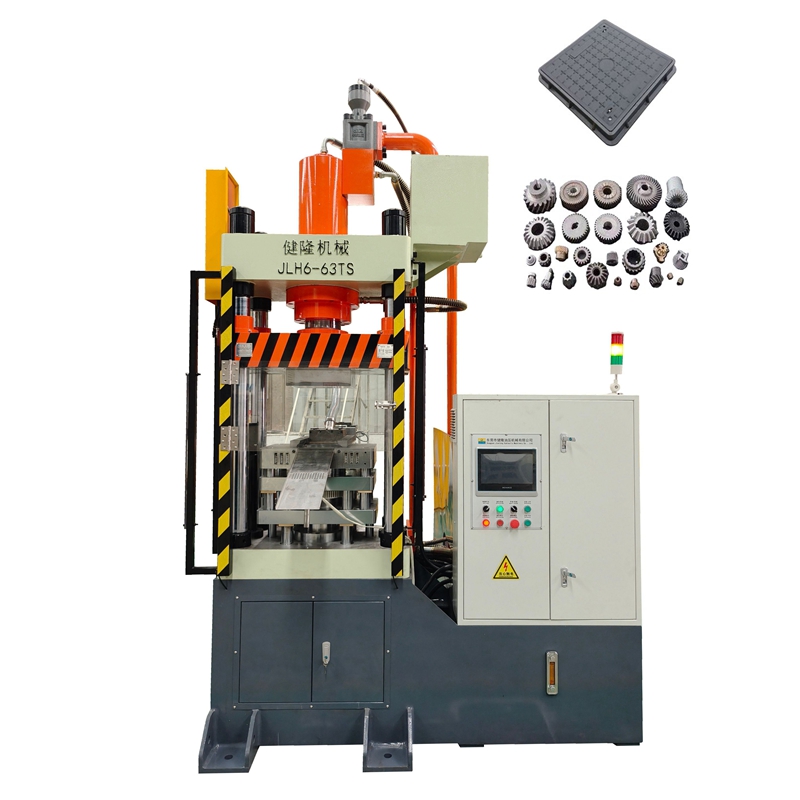Hydraulic presses play a key role in powder metallurgy forming process. They are mainly used in powder pressing (molding). Their high pressure, controllability and flexibility make them the core equipment for producing high-density and complex-shaped parts. The following is the specific application and characteristics of hydraulic presses in powder metallurgy forming process compiled by Jianlong Hydraulic Technology Team for reference!

1. The core role of hydraulic presses in powder forming
1.1 Pressing process
1.1.1 High-pressure forming: Hydraulic presses can provide tens to thousands of tons of pressure (usually 50~800 MPa) to press metal powder into high-density green compacts in the mold.
1.1.2 Pressure control: The hydraulic system maintains pressure for a period of time to reduce elastic aftereffect (expansion of the blank after demolding) and improve dimensional stability.
1.1.3 Multi-directional pressing: Complex parts (such as those with side holes or step structures) can use multi-directional hydraulic presses to achieve axial and radial synchronous pressurization to avoid uneven density.
1.2 Applicable process types
1.2.1 Unidirectional pressing: For simple-shaped parts (such as gaskets and bushings), the upper punch is pressurized in one direction and the lower die is fixed.
1.2.2 Bidirectional pressing: The upper and lower punches move simultaneously to improve the density distribution of parts with a large aspect ratio (such as gears).
1.2.3 Isostatic pressing (CIP): The powder package is uniformly pressurized through a hydraulic transmission medium (oil or water), which is used for special-shaped parts or large blanks (a special isostatic press is required).
2. Technical advantages of hydraulic presses
2.1 Precise and controllable pressure: The pressure curve is adjusted through a proportional valve or servo system to adapt to the compression characteristics of different powder materials (such as iron-based and copper-based).
2.2 Flexible production: Different parts can be produced by replacing the mold, which is suitable for small batches and multiple varieties.
2.3 High-density molding: Compared with mechanical presses, hydraulic presses can achieve higher and more uniform blank density (up to 85%~95% of the theoretical density).
2.4 Complex structure adaptation: Demolding, ejection and other automated operations are achieved through multi-action hydraulic cylinders (such as floating mold frames).
3. Typical application cases
3.1 Auto parts: engine connecting rods, gearbox gears (high density is required to withstand loads).
3.2 Oil-containing bearings: porous structures are formed by pressing, and then oil-immersed lubrication is performed.
3.3 Hard alloy: initial blank pressing of tungsten steel tools (ultra-high pressure is required).
3.3 Magnetic materials: directional pressing of NdFeB permanent magnets.

Hydraulic presses have become irreplaceable equipment in powder metallurgy molding due to their high pressure, flexibility and controllability, especially in the fields of high-performance parts, complex shapes and multi-material composite pressing. With technological advances, hydraulic presses are developing in a smarter and more efficient direction. For more knowledge sharing/suggestions on powder metallurgy molding processes or the need to purchase high-quality hydraulic presses, please feel free to tell us (you can scan the following WhatsApp QR code), Jianlong Hydraulic Technology will provide you with personalized, customized professional solutions and serve you wholeheartedly.

Contact: Jojo
Phone: 18822971180
E-mail: lifuyan78@gmail.com
Whatsapp:+8618822971180
Add: Guangyi Industrial Park, No.2 Jinfu West Road, Tanglip, Liaobu Town, Dongguan City, Guangdong Province, China
We chat
